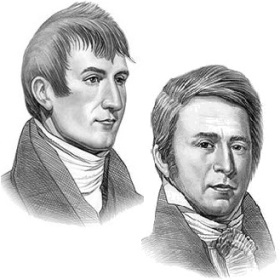|
We determined,
therefore, to examine well before we decided on our future course;
and for this purpose dispatched two canoes with three men up
each of the streams with orders to ascertain the width, depth,
and rapidity of the current, so as to judge of their comparative
bodies of water. At the same time parties were sent out by land
to penetrate the country, and discover from the rising grounds,
if possible, the distant bearings of the two rivers; and all
were directed to return towards evening. While they were gone
we ascended together the high grounds in the fork of these two
rivers, whence we had a very extensive prospect of the surrounding
country: on every side it was spread into one vast plain covered
with verdure, in which innumerable herds of buffalo were roaming,
attended by their enemies the wolves: some flocks of elk also
were seen, and the solitary antelopes were scattered with their
young over the face of the plain. To the south was a range of
lofty mountains, which we supposed to be a continuation of the
South mountain, stretching themselves from southeast to northwest,
and terminating abruptly about southwest from us. These were
partially covered with snow; but at a great distance behind
them was a more lofty ridge completely covered with snow, which
seemed to follow the same direction as the first, reaching from
west to the north of northwest, where their snowy tops were
blended with the horizon.
The direction
of the rivers could not however be long distinguished, as they
were soon lost in the extent of the plain. On our return we
continued our examination; the width of the north branch is
two hundred yards, that of the south is three hundred and seventy-two.
The north, although narrower and with a gentler current, is
deeper than the south: its waters too are of the same whitish
brown color, thickness, and turbidness: they run in the same
boiling and rolling manner which has uniformly characterized
the Missouri; and its bed is composed of some gravel, but principally
mud. The south fork is deeper, but its waters are perfectly
transparent: its current is rapid, but the surface smooth and
unruffled; and its bed too is composed of round and flat smooth
stones like those of rivers issuing from a mountainous country.
The air and character of the north fork so much resemble those
of the Missouri that almost all the party believe that to be
the true course to be pursued.
We however,
although we have given no decided opinion, are inclined to think
otherwise, because, although this branch does give the color
and character to the Missouri, yet these very circumstances
induce an opinion that it rises in and runs through an open
plain country, since if it came from the mountains it would
be clearer, unless, which from the position of the country is
improbable, it passed through a vast extent of low ground after
leaving them: we thought it probable that it did not even penetrate
the Rocky mountains, but drew it sources from the open country
towards the lower and middle parts of the Saskashawan, in a
direction north of this place. What embarrasses us most is,
that the Indians who appeared to be well acquainted with the
geography of the country, have not mentioned this northern river;
for "the river which scolds at all others," as it is termed,
must be according to their account one of the rivers which we
have passed; and if this north fork be the Missouri, why have
they not designated the south branch which they must also have
passed, in order to reach the great falls which they mention
on the Missouri. In the evening our parties returned, after
ascending the rivers in canoes for some distance, then continuing
on foot, just leaving themselves time to return by night.
The north
fork was less rapid, and therefore afforded the easiest navigation:
the shallowest water of the north was five feet deep, that of
the south six feet. At two and a half miles up the north fork
is a small river coming in on the left or western side, sixty
feet wide, with a bold current three feet in depth. The party
by land had gone up the south fork in a straight line, somewhat
north of west for seven miles, where they discovered that this
little river came within one hundred yards of the south fork,
and on returning down it found it a handsome stream, with as
much timber as either of the larger rivers, consisting of the
narrow and wide-leafed cottonwood, some birch and box-alder,
amid undergrowth of willows, rosebushes, and currants: they
also saw on this river a great number of elk and some beaver.
All these accounts were however very far from deciding the important
question of our future route, and we therefore determined each
of us to ascend one of the rivers during a day and a half's
march, or farther if necessary, for our satisfaction. Our hunters
killed two buffalo, six elk, and four deer to-day. Along the
plains near the junction, are to be found the prickly pear in
great quantities; the chokecherry is also very abundant in the
river low grounds, as well as the ravines along the river bluffs;
the yellow and red currants are not yet ripe; the gooseberry
is beginning to ripen, and the wildrose which now covers all
the low grounds near the rivers is in full bloom. The fatigues
of the last few days have occasioned some falling off in the
appearance of the men, who not having been able to wear moccasins,
had their feet much bruised and mangled in passing over the
stones and rough ground. They are however perfectly cheerful,
and have an undiminished ardour for the expedition.
Next Journal
Entry
|

